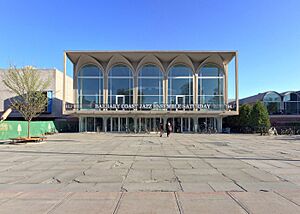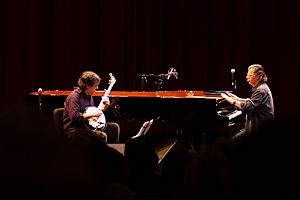Hopkins Center for the Arts facts for kids
The Hopkins Center for the Arts, often called "the Hop," is a special place at Dartmouth College in Hanover, New Hampshire. It's a lively center for arts and culture, designed by the famous architect Wallace Harrison. The Hop is home to the college's drama and music departments. Besides these, it also has a woodshop and a jewelry studio. Students and the public can use these studios to create their own art.
Contents
What Can You Do at the Hop?
The Hopkins Center has several performance spaces. These include Faulkner Recital Hall, Spaulding Auditorium, Warner Bentley Theater, the Moore Theater, and Alumni Hall. These spaces are used for many different events. You can watch student performances, concerts, and plays by visiting artists. They also host meetings for alumni and faculty.
Many student groups perform regularly at the Hop. These include the Dartmouth College Gospel Choir, Dartmouth Dance Ensemble, and the Glee Club. Other groups are the Barbary Coast Jazz Ensemble, the Wind Symphony, and the Symphony Orchestra. Students get a special lower price for tickets. All events are open to everyone, and you can buy tickets at the Hop's box office.
The center also offers various classes each term. These classes help students and the public learn new skills. For example, the dance department often teaches different dance styles. You might find classes from ballet to hip hop.
In 2014, many famous artists performed at the Hop. These included the musician Reggie Watts and the amazing American violinist Joshua Bell.
"Top of the Hop"
Sometimes, special events happen at the "Top of the Hop." This is an area on the second floor of the center. The college president often hosts parties here. These events celebrate important visitors, people who donate money, new art exhibits, or special performances.
History of the Hop
The Hopkins Center opened its doors in 1962. It was one of the very first arts centers of its kind at a college. Because of this, it became a model for many other arts centers built later. The idea for the Hop started in the late 1920s. Dartmouth president Ernest Martin Hopkins promised a new theater to Warner Bentley, who led the college's theater program.
Many things delayed the building's construction. These included the Great Depression and World War II. But when construction finally began in the early 1960s, the idea had grown much bigger. The new building would include a concert hall, a film theater, and a "black box" theater. It also had rehearsal halls for music and theater, a recital hall, and art galleries. There were also art studios and a student workshop. The new building covered a large area, about four and a half acres.
At first, the architects thought about a brick building in the Georgian style. This style matched many other buildings on the Dartmouth campus. But then, architect Wallace K. Harrison was hired. He was a favorite of Nelson A. Rockefeller, who was New York's governor and a Dartmouth graduate. Harrison changed the style to modern 1960s design. The front of the building has arches and glass. Harrison later used similar ideas when he designed the Metropolitan Opera House in New York City.
Arts were already important at Dartmouth before the Hop opened. There was a student theater company, the Glee Club, and a film society. But the goal was to get more students involved in the arts activities inside the new center. So, the design included lots of internal glass. Large windows looked into the theaters, design shops, practice rooms, and art studios. This was meant to invite students in.
The first directors, Warner Bentley and Peter D. Smith, started many public programs. These programs brought a lot of attention to the Hopkins Center. For many years in the 1960s, the Hop hosted a "Congregation of the Arts" in the summer. This included summer theater, a festival orchestra, and art exhibitions. The Hop became known as a place that welcomed new and modern music. In the 1970s, it also started "Celebration Northeast." This festival celebrated folk music from North America.
For many years, the Hop was ahead of its time in bringing in new performers. Peter Smith used to joke that he was the only person who couldn't sell out a 900-seat hall for Luciano Pavarotti or Bruce Springsteen. Both of these artists performed at the Hop just before they became huge superstars.
Connections to Other Places
The Hopkins Center is connected to the Hood Museum of Art. This museum is one of the oldest continuously operating museums in North America. It is Dartmouth's own museum, and it has both permanent art collections and visiting exhibitions. After walking through the museum, you can visit the Hood's museum store. This store is next to the Courtyard Café.



